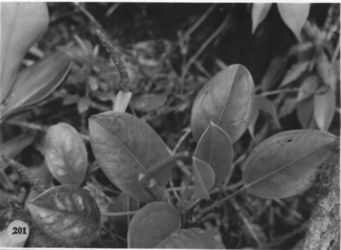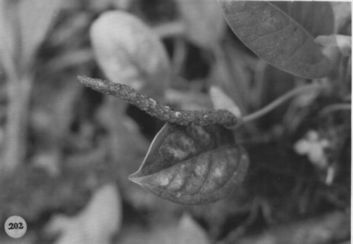





Anthurium tonduzii Engl.,
Bot. Jahrb. Syst. 25: 376. 1898. TYPE: Costa Rica. San José: near San Marcos, in forest near Alto de Pito, 1,400 m, Tonduz 7683 (B, holotype).
Epiphytie or terrestrial, usually creeping; stems elongate, rooting at nodes; the internodes 2-21 cm long; cataphylls to 8 cm long, early deciduous.
LEAVES erect-spreading; petioles subterete, narrowly and obscurely
sulcate, 1.5-12 cm long, 2-3 mm diam.; geniculum 1.4-2.3 cm long; blades
ovate to ovate-elliptic, moderately thick, gradually to abruptly acuminate
at apex, obtuse to rounded or rarely subcordate at base, 6-13 cm long,
3.5-8.5 cm wide; both surfaces glossy, the lower surface conspicuously
punctate; 1 (rarely 2) pair of basal veins, the innermost serving as the
collective vein; primary lateral veins 3-6 per
side, scarcely more conspicuous than the inter-primary veins, sunken
above, raised below; collective vein arising from the base, 4-5 mm from
the margin.
INFLORESCENCE erect-spreading, longer than leaves; the peduncle 3.5-14 cm long; spathe lanceolate, green tinged reddish, subcoriaceous, 1.5-3 cm long, 0.5-1 cm wide, abruptly acuminate at apex, acute at base; spadix green to red, scarcely tapered, 2.5-3 cm long, 4-5 mm diam. midway (dry); flowers rhombic to 4-lobed, ca. 2.2 mm long, 1.9 mm wide (dry), the sides straight to weakly sigmoid; 4-5 flowers visible in the principal spiral, ca. 7 flowers visible in the alternate spiral; lateral tepals 1.6 mm wide (dry), the inner margins straight to convex, pistils raised, weakly emergent; stigmas linear, 0.3-0.4 mm long; stamens emerging in a ± complete sequence from the base; anthers held in a tight cluster over pistil; thecae broadly ellipsoid.
INFRUCTESCENCE with spadix to 8 cm long; berries white, turning purple at maturity, oblong, ca. 1 cm long; mesocarp clear, gelatinous; seeds 2, dark violet-purple, ca. 4 mm long, 2 mm wide and 1.5 mm thick. Figs. 201 and 202.
Anthurium tonduzii occurs in Costa Rica and Panama at 800 to
1,500 m elevation in premontane rain and lower montane rain forest. It
has been collected on Cerro Pirre in Daricn Province of Panama and is to
be expected in Colombia in the Department ofChoco.
The type collection was made in 1893 and no collections have subsequently
been made in Costa Rica but the species has been collected five times between
1975 and 1977 in Panama.
Anthurium tonduzii is in section Tetraspermium
and does not appear to be related to any other species (certainly to no
Central American species), but it looks superficially like A.
scandens and A. trinerve because
of similar small, punctate leaves and scandent habit. It differs from both
by its longer internodes and entire deciduous cataphylls. The cataphylls
of A. scandens and A. trinerve soon weather into fibers and
persist, densely covering the stem.
 |
 |
Map of Mesoamerican specimens with coordinates
Costa Rica Costa Rica:, , Tonduz 17703 (B).
Costa Rica Lim—n: 1500 m, 9.22.50N 83.05.10W, 21 Mar. 1992, Herrera,
G. 5424 (MO, CR).
Costa Rica Lim—n: 1190 m, 9.23.10N 83.00.25W, 26 July 1989, Gerardo
Herrera 3352 (MO).
Costa Rica Lim—n: P.N. Cordillera de Talamanca; Cordillera de Talamanca,
1350 m, 09.23.50N 83.05.10W, 17 Mar 1992, Herrera 5376 (CR, MO).
Costa Rica San José: 1100-1200 m, 09.33.30N 84.03.15W, 5 September
1996, Thomas B. Croat 78903 (INB, MO).
Costa Rica San José: 1100, 9.17.41N 83.45.51W, 23 FEB 1996, Barry Hammel
20195 (INB).
Panama : 1450-1480 m, 8.35N 81.50W, 6 July 1988, Thomas B. Croat 69038
(MO).
Panama Bocas del Toro: 1200 m, 8.45N 82.15W, 4 Dec 1985, Gordon McPherson
7758 (MO).
Panama Chiriquí: 1100-1135 m, 8.43N 82.17W, 8 March 1985, T.B. Croat
& M.H. Grayum 59956 (MO).
Panama Chiriquí: 1170 m, 8.44N 81.17W, 23 June 1987, Thomas B. Croat
66679 (MO).
Panama Chiriquí: 1100 m, 8.45N 82.15W, 29 April 1986, Gordon McPherson
9128 (MO).
Panama Chiriquí: 1100 m, 8.45N 82.13W, 8 Feb. 1984, H.W. Churchill,
G. de Nevers & H. Stockwell 4916 (MO).
Panama Chiriquí: 1100 m, 8.45N 82.14W, 18 Sept. 1984, H.W. Churchill
& A. Churchill 6104 (MO).
Panama Chiriquí: 1100 m, 8.45N 82.13W, 8 Feb. 1984, H.W. Churchill,
G. de Nevers & H. Stockwell 4805 (MO).
Panama Chiriquí: 1200-1500 m, 8.47N 82.13W, 25 May 1984, H.W. Churchill
5302 (MO).
Panama Chiriquí: 1200 m, 8.47N 82.13W, 6 Feb.1984, H.W. Churchill,
G. de Nevers & H. Stockwell 4656 (MO).
Panama Chiriquí:, 7 December 1997, D.W. Roubik & L. Quroz 1266
.
Panama CoclŽ: 900-1000 m, 8.37N 80.08W, 13 July 1987, Thomas B. Croat
67259 (MO).
Panama CoclŽ: 1050-1180 m, 08.40N 80.10W, 22 January 1988, Gordon McPherson
11963 (MO).
Panama CoclŽ: 900 m, 8.35N 80.05W, 26 December 1982, Bruce A. Stein
Clement W. Hamilton 1004 (MO).
Panama Veraguas: 1250-2350 m,, 30 Nov. 1979, Thomas B. Croat 48954
(MO).
Map of South American Specimens with coordinates
Colombia Antioquia: 1990 m, 06.44N 76.23W, 6 November 1988, James L.
Zarucchi, G.McPherson,F.J.Roldán & O.Escobar 7208 (COL, HUA,
MO). Colombia Antioquia:, 21 Sept 1981, Jorge Brand & A. Cogollo 124
(JAUM).
Colombia Antioquia: 80 m,, 21 Sept 1981, Jorge Brand & A. Cogollo
133 (JAUM). Colombia Antioquia: 80 m,, 21 Sept 1981, Jorge Brand &
A. Cogollo 135 (JAUM).
Colombia Valle del Cauca: Bajo Calima, 50 m, 03.59N 77.02W, 10 April
1987, Al Gentry, M. Monsalve, D. Faber-Langendoen & M.D. Heredia 56756
(MO).
Colombia Valle del Cauca: 1900 m, 03.30N 76.34W, 3 Abr 1994, J.G. Gensini
& Carmen Espinosa 254 .
Colombia Valle del Cauca: 1900 m, 03.30N 76.34W, 4 Abr 1994, J. Giraldo
258 (MO).
Colombia Valle del Cauca: 1900 m, 03.30N 76.34W, 12 Mar 1995, J.G.
GEnsini & L.O. Agredo 622 (CUVC, MO).
Colombia Valle del Cauca: 1900 m, 03.30N 76.34W, 13 Mar 1994, J.G.
Gensini & L.O. Agredo 227 (CUVC, MO).
Colombia Valle del Cauca: 1900 m,, 4 Abril 1994, Jorge Giraldo Gensini
258 (CUVC, MO).